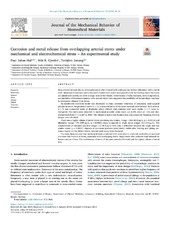| dc.contributor.author | Høl, Paul Johan | en_US |
| dc.contributor.author | Gjerdet, Nils Roar | en_US |
| dc.contributor.author | Jonung, Torbjörn | en_US |
| dc.date.accessioned | 2020-08-14T12:15:27Z | |
| dc.date.available | 2020-08-14T12:15:27Z | |
| dc.date.issued | 2019 | |
| dc.Published | Høl PJ, Gjerdet NR, Jonung T. Corrosion and metal release from overlapping arterial stents under mechanical and electrochemical stress - An experimental study. Journal of The Mechanical Behavior of Biomedical Materials. 2019;93:31-35 | eng |
| dc.identifier.issn | 1751-6161 | |
| dc.identifier.issn | 1878-0180 | |
| dc.identifier.uri | https://hdl.handle.net/1956/23778 | |
| dc.description.abstract | Intra-arterial stenosis due to atherosclerosis is often treated with endovascular balloon dilatation with a metal stent. Restenosis is common and is frequently treated with a new stent placed inside the existing one or the stents are placed with overlap to cover a larger area of the vessels. Observations of stent fractures, stent compression, accumulation of immunocompetent cells around stents have suggested the possibility of immunologic reactions to substances released from stents. An accelerated corrosion model was developed to study corrosion behaviour of commonly used surgical peripheral stents. Single nitinol stents (n=6), connected stents of the same material (stent-in-stent, both nitinol, n=7) and connected stents of dissimilar alloys (Nitinol with stainless steel stent inside, n=7) were investigated. The stents were subjected to mechanical pulsatile radial strain (up to 8% strain at 1Hz) and electrochemical stress (+112mV vs. SCE). The release of nickel and titanium ions was compared. Scanning electron images were obtained. There was a higher release of nickel when combining two similar (range: 1382-8018mug/L, p=0.0012) and dissimilar (range: 170-2497mug/L, p=0.0023) stents compared to single stents (range: 0.4-216mug/L). The concentration of titanium was low (range: 1.6-98.4mug/L) with only a difference between the single and two similar stents (p=0.0047). Deposits of corrosion products were clearly visible after fretting and pitting corrosion mainly on the Nitinol stents. Several mesh wires were fractured. The study demonstrated that mechanical strain combined with weak electric potential resulted in pronounced corrosion and fracture of stents, especially with overlapping stents. Single stents after pulsatile load released the lowest amount of ions. The combination of stents of the same material (Nitinol) had the highest release of metal ions. | en_US |
| dc.language.iso | eng | eng |
| dc.publisher | Elsevier | eng |
| dc.rights | Attribution CC BY | eng |
| dc.rights.uri | http://creativecommons.org/licenses/by/4.0/ | eng |
| dc.title | Corrosion and metal release from overlapping arterial stents under mechanical and electrochemical stress - An experimental study | en_US |
| dc.type | Peer reviewed | |
| dc.type | Journal article | |
| dc.date.updated | 2020-01-15T14:30:33Z | |
| dc.description.version | publishedVersion | en_US |
| dc.rights.holder | Copyright 2019 The Author(s) | |
| dc.identifier.doi | https://doi.org/10.1016/j.jmbbm.2019.02.001 | |
| dc.identifier.cristin | 1682362 | |
| dc.source.journal | Journal of The Mechanical Behavior of Biomedical Materials | |
| dc.relation.project | Bergens forskningsstiftelse: BFS2010REK01 | |

